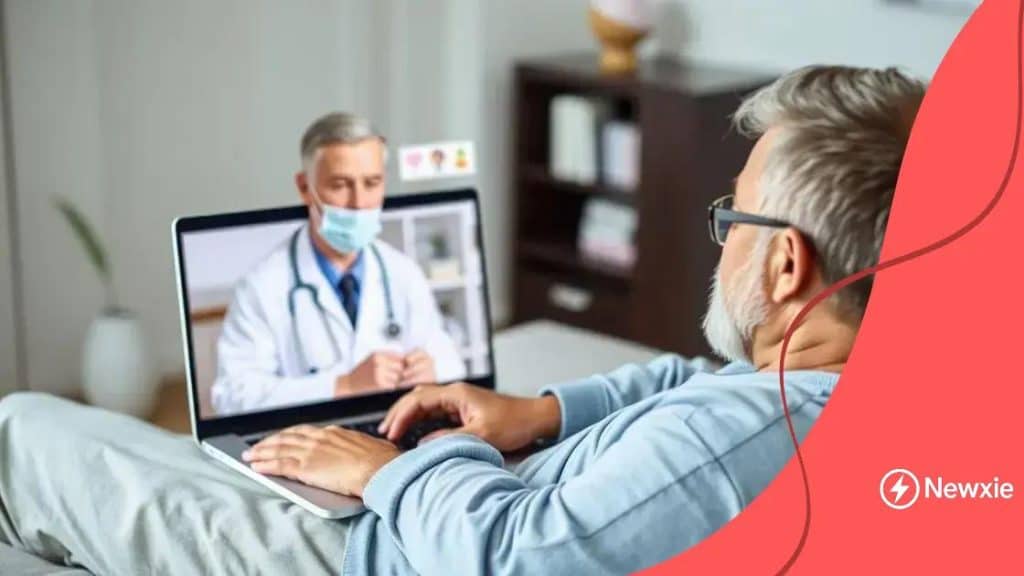Telehealth services availability: Are you covered?

Anúncios
Telehealth services provide convenient access to healthcare through digital technology, allowing patients to consult with providers remotely and benefiting from increased accessibility and reduced travel time.
Telehealth services availability is changing how we approach healthcare. Have you ever considered how virtual appointments can save you time and effort? Let’s dive into this evolving field.
Anúncios
Understanding telehealth services
Understanding telehealth services is essential in today’s digital era. As healthcare access evolves, these services are reshaping how we interact with medical professionals.
What Are Telehealth Services?
Telehealth refers to the use of technology to deliver medical care remotely. This includes a variety of services such as virtual consultations, remote monitoring, and digital health resources. Patients can receive care from the comfort of their homes, reducing the need for in-person visits.
Benefits of Telehealth Services
Telehealth offers several advantages:
Anúncios
- Accessibility: Patients in remote areas can access specialists.
- Convenience: Appointments can be scheduled easily without long waiting times.
- Cost-Effectiveness: Telehealth can reduce travel costs and time off work.
Moreover, many patients find that telehealth services allow for faster communication with their healthcare providers. This quick access can lead to timely interventions, improving overall health outcomes.
As technology advances, telehealth will likely continue to gain traction. Users can expect to see improvements in the quality of virtual care, as well as an expanding range of services offered through this medium.
Benefits of telehealth for patients
The benefits of telehealth for patients are numerous and significant. With the rise of technology in healthcare, patients are finding new ways to manage their health efficiently and conveniently.
Convenience
One of the most notable advantages is convenience. Patients can schedule appointments at times that work best for them, eliminating travel time. This is particularly helpful for those with busy schedules or mobility issues.
Improved Access
Telehealth also enhances access to healthcare services. Individuals in rural or underserved areas can connect with specialists without the need to travel long distances. This opens up a world of opportunities for proper care.
- Access to specialists who may not be available locally.
- Ability to see professionals from multiple disciplines without logistical challenges.
- Reduced need for travel, saving time and effort.
Additionally, telehealth offers greater flexibility. Patients can choose virtual visits for follow-ups or routine check-ups, which can be done from home. This often leads to better satisfaction and adherence to treatment plans.
Another major benefit is the use of technology. Patients can utilize various tools for self-monitoring, which can be shared with their doctors during consultations. These tools can track vital signs, medication adherence, and more, allowing for better-informed decisions regarding their health.
How to access telehealth services

Accessing telehealth services is a straightforward process that can significantly improve your healthcare experience. With just a few easy steps, you can connect with healthcare providers from the comfort of your home.
Find a Provider
The first step is to find a healthcare provider that offers telehealth options. Many hospitals and clinics now have virtual care services, so checking their websites or calling for information is a great start.
Schedule an Appointment
Once you’ve identified a provider, scheduling an appointment is typically done online or via a phone call. Look for an easy way on their website to book your virtual visit. You may be asked for some basic information, including your insurance details and medical history.
- Check the provider’s availability.
- Choose a convenient date and time.
- Review any pre-visit instructions.
After scheduling, you will receive confirmation, which often includes a link to access the telehealth platform. It is essential to read through the confirmation email thoroughly for any specific requirements.
Before your appointment, make sure you have a reliable internet connection and a device that supports video calls. Commonly used devices include smartphones, tablets, and computers. Ensure that your camera and microphone are working well, which allows for clear communication with your doctor.
Using the Telehealth Platform
The day of your appointment, click the link provided in your confirmation email to join the virtual visit. You may need to log in to the telehealth platform using an account created during the scheduling process. After logging in, wait for your healthcare provider to join the session.
During the visit, it’s helpful to have your list of questions ready and any necessary medical information at hand. This preparation ensures you make the most of your time with your healthcare professional.
Challenges in telehealth availability
Despite the growth of telehealth availability, several challenges still persist. These challenges can affect how patients and providers utilize telehealth services effectively.
Technological Barriers
One common barrier is technology. Not all patients have access to reliable internet connections or the devices needed for virtual care. This can limit those in rural or low-income areas from benefiting from telehealth services.
Understanding Platforms
Moreover, not everyone is familiar with telehealth platforms. Patients who are not tech-savvy may find it difficult to navigate the necessary software for appointments. This can lead to frustration and deter individuals from using these valuable services.
- Providing age-appropriate training for older adults.
- Offering technical support during appointments.
- Creating user-friendly interfaces for telehealth applications.
Another issue is regulatory challenges. Different states have varying laws concerning telehealth services, which can complicate access. For instance, some providers might not be able to offer services across state lines due to licensing restrictions.
Additionally, insurance coverage for telehealth can be inconsistent. Many patients may still face high out-of-pocket costs, which can make accessing care difficult. Understanding what is covered by their plan is crucial for patients considering virtual visits.
These challenges highlight the need for ongoing improvements in telehealth services. By addressing these issues, healthcare systems can ensure that more people benefit from this innovative approach to healthcare.
Future trends in telehealth services
The future of telehealth services looks bright and promising. As technology continues to advance, these services will evolve, providing even more benefits to patients and healthcare providers.
Integration of Artificial Intelligence
One major trend is the integration of artificial intelligence in telehealth. AI can assist in diagnosing conditions, analyzing patient data, and streamlining administrative tasks. This can lead to more efficient care and improved patient outcomes.
Expansion of Services
Additionally, we can expect an expansion of telehealth services. More specialties are likely to adopt virtual consultations, which will allow for better access to a wide range of medical professionals. Mental health services, for instance, have already seen significant growth through telehealth platforms.
- Increased availability of teletherapy sessions.
- Long-term care management through virtual visits.
- Remote monitoring devices for chronic conditions.
Moreover, regulatory changes will likely support the growth of telehealth. As more states adopt favorable laws, interstate healthcare delivery will become increasingly commonplace. This could make it easier for patients to receive care from out-of-state specialists.
Patient engagement will also improve through enhanced telehealth tools. Users may have access to apps that monitor their health and enable better communication with healthcare providers. These apps can lead to more personalized care and better adherence to treatment plans.
Focus on User Experience
Finally, the focus on user experience will take center stage. Telehealth platforms will become more intuitive and user-friendly, reducing the barriers for patients. As healthcare providers emphasize accessibility, more individuals will feel comfortable using these services.
FAQ – Frequently Asked Questions about Telehealth Services
What are telehealth services?
Telehealth services allow patients to consult with healthcare providers using digital technology, like video calls, improving access to care.
How do I access telehealth services?
You can access telehealth services by finding a provider that offers them, scheduling an appointment online, and using a device with a reliable internet connection.
What are the benefits of using telehealth?
Benefits include convenience, improved access to specialists, and the ability to receive care from home, saving time and effort.
Are there any challenges with telehealth?
Some challenges include technological barriers, varying insurance coverage, and regulatory issues that can impact access to care.
SEE MORE CONTENT




